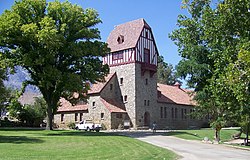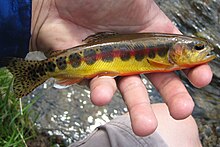
Trout is a generic common name for numerous species of carnivorous freshwater ray-finned fishes belonging to the genera Oncorhynchus, Salmo and Salvelinus, all of which are members of the subfamily Salmoninae in the family Salmonidae. The word trout is also used for some similar-shaped but non-salmonid fish, such as the spotted seatrout/speckled trout.

Pyramid Lake is the geographic sink of the basin of the Truckee River, 40 mi (64 km) northeast of Reno, Nevada, United States.
The National Fish Hatchery System (NFHS) was established by the U.S. Congress in 1871 through the creation of a U.S. Commissioner for Fish and Fisheries. This system of fish hatcheries is now administered by the Fisheries Program of the U.S. Fish and Wildlife Service (Service), an agency within the United States Department of the Interior.

Walker Lake is a natural lake in the Great Basin in western Nevada in the United States. It is 11 mi (17 km) long and 5 mi (8 km) wide, in northwestern Mineral County along the east side of the Wassuk Range, about 75 mi (120 km) southeast of Reno. The lake is fed from the north by the Walker River and has no natural outlet except absorption and evaporation. The community of Walker Lake is found along the southwest shore.

The Kern River, previously Río de San Felipe, later La Porciúncula, is an Endangered, Wild and Scenic river in the U.S. state of California, approximately 165 miles (270 km) long. It drains an area of the southern Sierra Nevada mountains northeast of Bakersfield. Fed by snowmelt near Mount Whitney, the river passes through scenic canyons in the mountains and is a popular destination for whitewater rafting and kayaking. It is the southernmost major river system in the Sierra Nevada, and is the only major river in the Sierra that drains in a southerly direction.
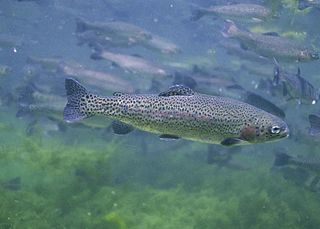
The rainbow trout is a species of trout native to cold-water tributaries of the Pacific Ocean in North America and Asia. The steelhead is an anadromous (sea-run) form of the coastal rainbow trout(O. m. irideus) or Columbia River redband trout (O. m. gairdneri) that usually returns to freshwater to spawn after living two to three years in the ocean. Freshwater forms that have been introduced into the Great Lakes and migrate into tributaries to spawn are also called steelhead.

The cutthroat trout(Oncorhynchus clarkii) is a fish species of the family Salmonidae native to cold-water tributaries of the Pacific Ocean, Rocky Mountains, and Great Basin in North America. As a member of the genus Oncorhynchus, it is one of the Pacific trout, a group that includes the widely distributed rainbow trout. Cutthroat trout are popular gamefish, especially among anglers who enjoy fly fishing. The common name "cutthroat" refers to the distinctive red coloration on the underside of the lower jaw. The specific name clarkii was given to honor explorer William Clark, coleader of the Lewis and Clark Expedition.

Lahontan cutthroat trout is the largest subspecies of cutthroat trout and the state fish of Nevada. It is one of three subspecies of cutthroat trout that are listed as federally threatened.

The Mount Massive Wilderness is a federally designated wilderness area in the Sawatch Range, located in the U.S. state of Colorado. It is operated jointly by the United States Forest Service and the Fish and Wildlife Service as part of the San Isabel National Forest and the Leadville National Fish Hatchery. It is 30,540 acres (123.6 km2) in size, with 27,980 acres (113.2 km2) in San Isabel National Forest and 2,560 acres (10.4 km2) in Leadville National Fish Hatchery, and it was designated by the US Congress in 1980. The name comes from Mount Massive, the second highest peak in Colorado, located inside the wilderness. Elevations in the wilderness range from 9,700 feet (3,000 m) to 14,421 feet (4,396 m). It is the only federally designated wilderness area within the National Fish Hatchery System.

The California Department of Fish and Wildlife (CDFW), formerly known as the California Department of Fish and Game (CDFG), is an American state agency under the California Natural Resources Agency. The Department of Fish and Wildlife manages and protects the state's wildlife, wildflowers, trees, mushrooms, algae and native habitats (ecosystems). The department is responsible for regulatory enforcement and management of related recreational, commercial, scientific, and educational uses. The department also prevents illegal poaching.

Paiute cutthroat trout is one of fourteen subspecies of cutthroat trout. Paiute Cutthroat are native only to Silver King Creek, a headwater tributary of the Carson River in the Sierra Nevada, in California. This subspecies is named after the indigenous Northern Paiute peoples.

Rush Creek is a 27.2-mile-long (43.8 km) creek in California on the eastern slope of the Sierra Nevada, running east and then northeast to Mono Lake. Rush Creek is the largest stream in the Mono Basin, carrying 41% of the total runoff. It was extensively diverted by the Los Angeles Aqueduct system in the twentieth century until California Trout, Inc., the National Audubon Society, and the Mono Lake Committee sued Los Angeles Department of Water and Power (LADWP) for continuous low flows in Rush Creek to maintain trout populations in good condition, which was ordered by the court in 1985.

The Golden Trout Wilderness is a federally designated wilderness area in the Sierra Nevada, in Tulare County and Inyo County, California. It is located 40 miles (64 km) east of Porterville within Inyo National Forest and Sequoia National Forest.

The Lake Fish Hatchery Historic District comprises nine buildings built between 1930 and 1932 by the U.S. Fish and Wildlife Service in the National Park Service Rustic style. The buildings exhibit a consistency of style and construction, with exposed gable trusses and oversized paired logs at the corners, all with brown paint. The district is located on the shore of Yellowstone lake near the Lake Hotel The hatchery was established to provide Yellowstone cutthroat trout eggs for state and federal hatcheries outside Yellowstone.

The Carson–Iceberg Wilderness is a federal wilderness area located 80 miles (130 km) northeast of Stockton, California. It encompasses 160,000 acres (650 km2) and was designated by the California Wilderness Act of 1984. It protects an area of High Sierra landscape with elevations from 4,800 feet (1,500 m) to 11,462 feet (3,494 m) along the Sierra Mountains from Ebbetts Pass to Sonora Pass in the south. The US Forest Service manages the wilderness which is in both the Stanislaus National Forest and the Humboldt–Toiyabe National Forest.
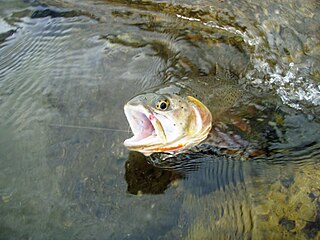
The cutbow is an interspecific fertile hybrid between rainbow trout and cutthroat trout. While natural separation of spawning habitat limited hybridization in most native populations of rainbow and cutthroat trout, introduction of non-native hatchery-raised rainbow trout into native cutthroat trout range increased hybridization across the landscape. Due to these introductions, many populations of cutthroat trout are at risk of genetic pollution. As a result, significant management intervention at state and federal levels has occurred to preserve native populations of cutthroat trout.
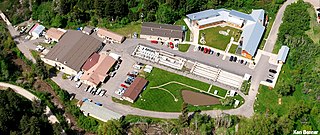
The Bozeman National Fish Hatchery, now known as Bozeman Fish Technology Center, is located about 4 miles (6.4 km) northeast of Bozeman, Montana, at the entrance to Bridger Canyon. There is also a National Fish Health Center on the southwest side of Bozeman, near Montana State University, about 7 miles (11 km) away from the Fish Technology Center. Fish Technology Centers work with a wide variety of public and private partners to improve and conserve aquatic resources. Both the Fish Technology Center and the Fish Health Center are part of the National Fish Hatchery System, operated by the United States Fish and Wildlife Service. There are seven Fish Technology Centers and nine Fish Health Centers in the United States. The Bozeman hatchery is the fourth oldest National Fish Hatchery. The hatchery was named to the National Register of Historic Places on January 6, 1983.
The Bellvue-Watson Fish Hatchery is a Colorado Parks and Wildlife cold water fish production facility located near Cache la Poudre River and Watson Lake State Wildlife Area in Larimer County, Colorado. Hatchery staff works to support the raising of approximately 1.5 million sub-catchable trout annually. The Watson Lake Rearing Unit, a division within the hatchery, is responsible for rearing approximately 300,000 catchable trout each year. The hatchery stocks fishing sports in Wellington, Fort Collins, Loveland, Longmont and Jumbo Reservoir near Julesburg and Hale ponds.
The Mt. Shavano Hatchery is a Colorado Parks and Wildlife cold-water fish hatchery situated near Arkansas River headwaters at the base of Big Baldy Mountain in Chaffee County. This facility is renowned as one of the largest trout units in the state.
The Pitkin Hatchery is a Colorado Parks and Wildlife cold water fish production facility located in Gunnison National Forest right off of Quartz Creek Valley in Gunnison County.
